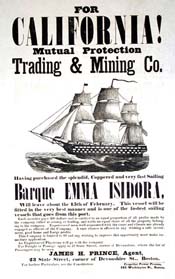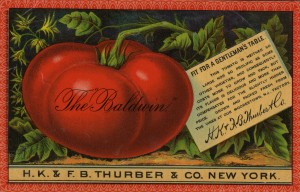A recent reference question reminded me just how many amazing bibliographies there are, and it also sparked a memory of a wonderful cache of letters in AAS’s manuscript collection that give an insider’s view of the ’49er experience. (The entire Grant-Burr Family Papers are fully transcribed online, including the letters on the California Gold Rush.)
are fully transcribed online, including the letters on the California Gold Rush.)
What prompted my reverie was an email from a woman wondering if her ancestor was listed in the reference work by Louis Rasmussen, California Wagon Train Lists. While not strictly a bibliography, this reference work transcribes the lists of passengers traveling west to California that appeared in local papers across the country. Since the book was on the shelf right outside my door, I offered to check the index rather than have her drive up from Connecticut. And while I was looking for her ancestor, I thought I may as well take a look to see if I could track down our Daniel Grant from the Grant-Burr Family Papers.
Now, I’m ashamed to admit I didn’t already know about Rasmussen’s book. I fear I will be made to stand in a corner, down one of the many aisles of bibliographies in the reading room, with my face to the shelf for ‘fessing up to this fact. To comfort myself, a quick look around the packed shelves of the AAS reading room reminds me it’s not surprising I wasn’t already familiar with Rasmussen’s California Wagon Train Lists. We have almost 3,000 titles in the Bibliography (or BIB) collection alone.  One person can’t be expected to know all of them, I tell myself. For instance, did anyone know there was a bibliography on tomatoes? Not only is there one, there are actually two in the AAS reading room! (The second one is really another edition of the first, so perhaps that’s cheating.)
One person can’t be expected to know all of them, I tell myself. For instance, did anyone know there was a bibliography on tomatoes? Not only is there one, there are actually two in the AAS reading room! (The second one is really another edition of the first, so perhaps that’s cheating.)
As modern day researchers, we owe an immeasurable debt to those bibliographers and editors who slogged through thousands of volumes of newspapers to index them or read through other sources to pull out all the citations referring to one subject area. Although I called the debt immeasurable, if anyone could measure it, it would be the bibliographers. Indeed, there are bibliographies of bibliographies. It takes a certain kind of genius to do this kind of work and all of the rest of us benefit from the labor.
This research story has a happy ending. It turns out the ancestor of our inquirer was listed in Rasmussen’s book. Next week I’ll let you know if I was able to find Daniel Grant in there as well, and I’ll include selections from his letters and those of his brother-in-law, Ralph E. Burr, who followed him to California. So get your wagon train ready — we’re heading west!

One thought on “Bibliographies: from the Gold Rush to Tomatoes”